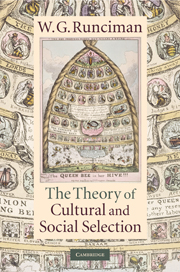Book contents
- Frontmatter
- Contents
- Preface
- Prologue: The Darwinian legacy
- 1 The neo-Darwinian paradigm
- 2 Natural selection and evoked behaviour
- 3 Cultural selection and acquired behaviour
- 4 Social selection and imposed behaviour
- 5 Selectionist theory as narrative history
- Epilogue: Sociology in a post-Darwinian world
- References
- Index
3 - Cultural selection and acquired behaviour
Published online by Cambridge University Press: 05 June 2012
- Frontmatter
- Contents
- Preface
- Prologue: The Darwinian legacy
- 1 The neo-Darwinian paradigm
- 2 Natural selection and evoked behaviour
- 3 Cultural selection and acquired behaviour
- 4 Social selection and imposed behaviour
- 5 Selectionist theory as narrative history
- Epilogue: Sociology in a post-Darwinian world
- References
- Index
Summary
BELIEFS AND ATTITUDES
How then should comparative sociologists proceed when contrasting one human culture or sub-culture with another? What kind of just-so story will best explain why these and not those memes are the ones being acquired and acted out?
However the process of heritable variation and competitive selection of memes is modelled, it will have to be estimated as accurately as possible just how widely the distinctive beliefs and attitudes and the representations underlying them are distributed among the population of carriers. Obvious as this may be, there are more instances than there should be in the historical and ethnographic literature where an author implies without sufficient qualification that the members of the culture chosen for study were all carrying much the same bundles of memes inside their heads. It might turn out that some representations, at least, are shared with only insignificant differences between the information in one native's head and another's. Perhaps every Hellene shares a broadly similar representation of Zeus, every Navajo a broadly similar representation of hozho (harmony, beauty), and every Polynesian a broadly similar representation of mana. But the ideal type of a traditional culture, in which every native holds exactly the same beliefs and shares exactly the same attitudes, has never been more than that. Not only does there have to be an explanation of how an allegedly unquestioned set of inherited memes came to be selected in the first place, but the capacity of the human mind actively to reinterpret or reconstruct any inherited meme means that any complex of memes by which the natives' collective behaviour is guided is likely to be challenged by at least some of the members of each successive generation.
- Type
- Chapter
- Information
- The Theory of Cultural and Social Selection , pp. 92 - 139Publisher: Cambridge University PressPrint publication year: 2009



